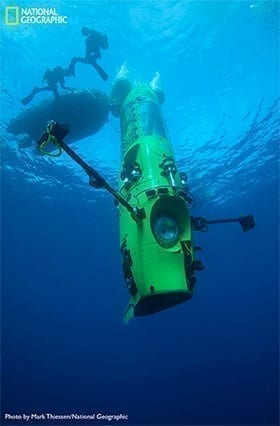
In addition to the DEEPSEA CHALLENGER itself, Cameron is kicking in nearly $1 million to help WHOI scientists and engineers make the sub’s technology more widely available for deep-sea exploration.
Before setting his sights once again on the far-off moon Pandora for the next Avatar adventure, filmmaker and aquanaut James Cameron has bequeathed arguably his greatest technological accomplishment to science. Cameron’s DEEPSEA CHALLENGER submarine, which he drove to the deepest part of this planet last March, will in June arrive at Woods Hole Oceanographic Institution (WHOI) in Massachusetts, ultimately helping researchers there better understand life in Earth’s last unexplored frontier.
“Most of what’s known about the bottom of the ocean has come from images shot miles up in the water column, and it’s a relatively coarse data set,” Cameron said recently at roundtable discussion in New York City with WHOI scientists who design, build and operate manned and robotic deep-sea exploration vehicles. “So you’ve got to get down there and look around and ground-truth it,” he added. “Very little of that looking around has been done.”
Cameron and his team of engineers outfitted the DEEPSEA CHALLENGER with cutting-edge flotation mechanisms and energy storage systems, along with cameras, lighting and other features specifically tailored for gathering data, samples and images during the first manned mission to the deepest recess of the Mariana Trench. He touched down about 11 kilometers below the Pacific Ocean surface at the Challenger Deep site, a spot previously visited by only a handful of robotic subs. During the seven-hour round-trip, Cameron spent about three hours at Challenger Deep collecting samples for marine biology, microbiology, astrobiology, marine geology and geophysics research.
In addition to the DEEPSEA CHALLENGER itself, Cameron is kicking in nearly $1 million to help WHOI scientists and engineers make the sub’s technology more widely available for deep-sea exploration. “We’ve been be sure to fund this enough that there are enough people and resources available to write this up, publish it and therefore have it available,” he said. “To me, that’s an infinitely better outcome than [the sub] sitting dormant until I’m done with my next two movies, and maybe it comes to the tech community five or six years down the line when it’s already obsolete.”
The Latest Bing News on:
DEEPSEA CHALLENGER
- A Glimpse Of Life In The Deep Sea: Announcing The Winners Of The 2024 Science Without Borders® Challengeon May 8, 2024 at 12:18 pm
More students entered the Science Without Borders® Challenge than ever before, sending in beautiful artwork illustrating the vast array of life adapted to live in the deepest parts of our ocean. The ...
- Using algorithms to decode the complex phonetic alphabet of sperm whaleson May 7, 2024 at 9:03 am
The allure of whales has stoked human consciousness for millennia, casting these ocean giants as enigmatic residents of the deep seas. From the biblical Leviathan to Herman Melville's formidable Moby ...
- 7 Unique Watches That Hold World Recordson May 2, 2024 at 11:00 pm
From the deepest dive watch by Rolex to the thinnest watch by Richard Mille, we look at some amazing watches with world records.
- HK'S BLUE WARRIOR TRIUMPHS AT LISC 2024 DAIWA INTL DEEP SEA CHALLENGEon April 28, 2024 at 2:38 am
The Daiwa International Deep Sea Fishing Challenge 2024, a key event of the 26th Edition of the Labuan International Sea Challenge (LISC), concluded today with the Hong Kong team Blue Warrior emerging ...
- How deep does life go?on April 25, 2024 at 5:01 am
When HMS Challenger set sail in 1872 ... to 75 centimeters long taken off the coast of Southern California. The deep sea and its creatures became a subject of great interest in the 1930s, prompted ...
- DraftKings: New Deep Pocked Entries Pose No Challenge To Its Market Shareon April 24, 2024 at 10:20 am
DraftKings Inc. aims to maintain its 40%+ market share amidst new competitors entering the market. DraftKings is projected to become profitable in 2023, with revenue expected to reach $4.77 ...
- The Deep Sea: Exploring the Uncharted Depths of Earth’s Oceanson April 19, 2024 at 9:27 am
The deep sea, a realm of darkness, mystery, and immense pressure, covers over 65% of Earth’s surface and remains one of the least explored and understood regions on our planet. Far beneath the sunlit ...
- ‘The Challenge: All Stars’ Showrunner Peels Back the Curtain on New Seasonon April 8, 2024 at 5:00 pm
Almost nobody in America had ever heard of him, and he became this beloved Challenge player almost overnight. He’s the best. The minute he walked on set, even for the crew, he was such a nice ...
- Voyage to the Deepon October 12, 2023 at 5:51 pm
Cameron smiled. “C’mon,” he said. “I’ll show you.” He led the Big Man and his entourage to where DEEPSEA CHALLENGER, a sleek, 24-foot submersible, rested in its cradle. In a few days ...
- This explorer dived to the ocean’s deepest seabed. He says the missing Titanic sub disaster was ‘avoidable’on June 21, 2023 at 4:07 pm
whenTitanic filmmaker James Cameron made the first solo voyage in the Deepsea Challenger submersible. Mr Walsh became the 11th person to make a successful dive to Challenger Deep in June 2020.
The Latest Google Headlines on:
DEEPSEA CHALLENGER
[google_news title=”” keyword=”DEEPSEA CHALLENGER” num_posts=”10″ blurb_length=”0″ show_thumb=”left”]
The Latest Bing News on:
Deep-sea exploration vehicles
- The deepest place on Earth: About the Mariana Trenchon May 8, 2024 at 8:16 pm
The trench is the deepest place on Earth, deeper than Mount Everest is high, located in the middle of the Pacific Ocean between Japan and Australia.
- The deep ocean photographer that captured a 'living fossil'on May 8, 2024 at 3:00 am
Scientists are racing to trace deep ocean species before they are lost, with the help of photographers who have a taste for danger.
- 5 Active Hydrothermal Vents Discovered Deep in Eastern Pacific Ocean—What Does This Mean?on May 7, 2024 at 9:55 pm
Situated at a depth of 2,550 meters, these vents represent fascinating phenomena where scorching water erupts through the ocean floor.
- Future Of Deep-Sea Mining Might Rest On International Seabed Authority Leadership Electionon May 7, 2024 at 9:44 am
International Seabed Authority preparing for leadership election in July to shape future of deep-sea mining. Potential for environmental impacts.
- Scripps Oceanography scientists to take part in deep-sea exploration off coast of Alaskaon May 6, 2024 at 10:55 pm
SAN DIEGO (FOX 5/KUSI) — A team of scientists from UC San Diego’s Scripps Institution of Oceanography is getting ready to explore the deep-sea ecosystems surrounding ... be using the autonomous ...
- Deep sea mining can provide metals for the green transitionon May 5, 2024 at 9:13 am
CMJ: As a conversation starter, could you please talk to us briefly about the history of deep sea mining and The Metals Company (TMC)? Also, how did you join TMC? CS: To tell the history of TMC, I ...
- Scripps Oceanography scientists to take part in deep-sea exploration off coast of Alaskaon May 3, 2024 at 11:03 am
SAN DIEGO (FOX 5/KUSI) — A team of scientists from UC San Diego’s Scripps Institution of Oceanography is getting ready to explore the deep-sea ecosystems surrounding methane seeps off the ...
- The Deep Sea: Exploring the Uncharted Depths of Earth’s Oceanson April 19, 2024 at 9:27 am
The deep sea, a realm of darkness, mystery, and immense pressure, covers over 65% of Earth’s surface and remains one of the least explored and understood regions on our planet. Far beneath the sunlit ...
- Exploration of the deep sea has much to offer for science, but caution needed for mining of its resourceson April 14, 2024 at 10:38 pm
Technological advancements have made mining an easier feat, with remotely operated mining vehicles plying the ... subjects as wide-ranging as deep sea exploration, trust in the digital age and ...
- Deep-sea creature — with yellowy tentacles and over 80 feet — is new species. See iton March 27, 2024 at 2:30 am
Researchers explored the South China Sea through a series of five dives on a “manned submersible vehicle” between ... “to the field of deep-sea exploration.” Both of the study co-authors ...
The Latest Google Headlines on:
Deep-sea exploration vehicles
[google_news title=”” keyword=”deep-sea exploration vehicles” num_posts=”10″ blurb_length=”0″ show_thumb=”left”]









